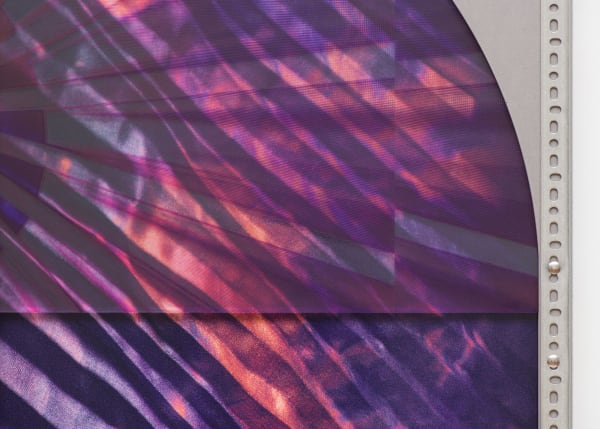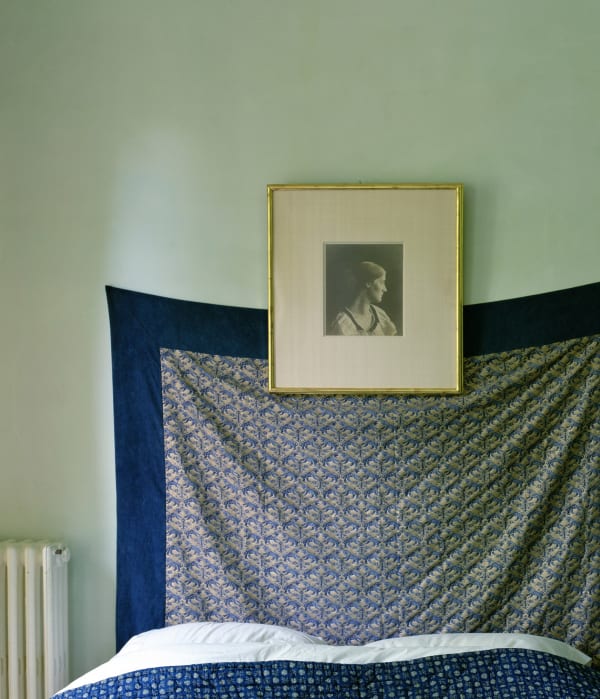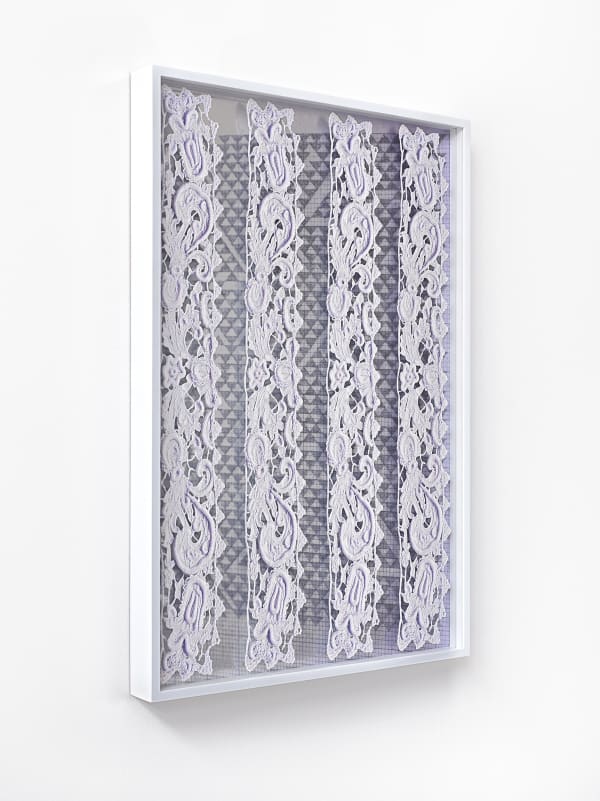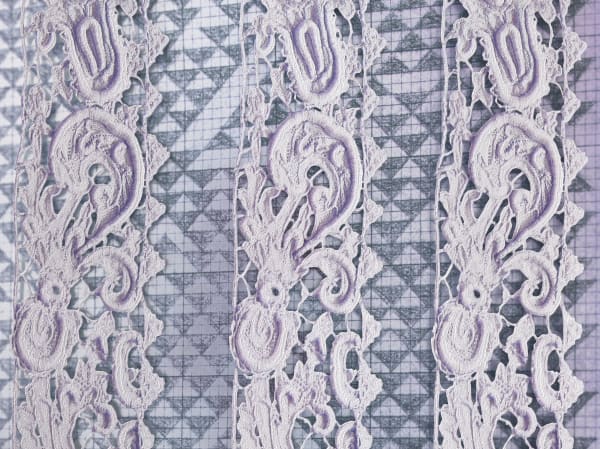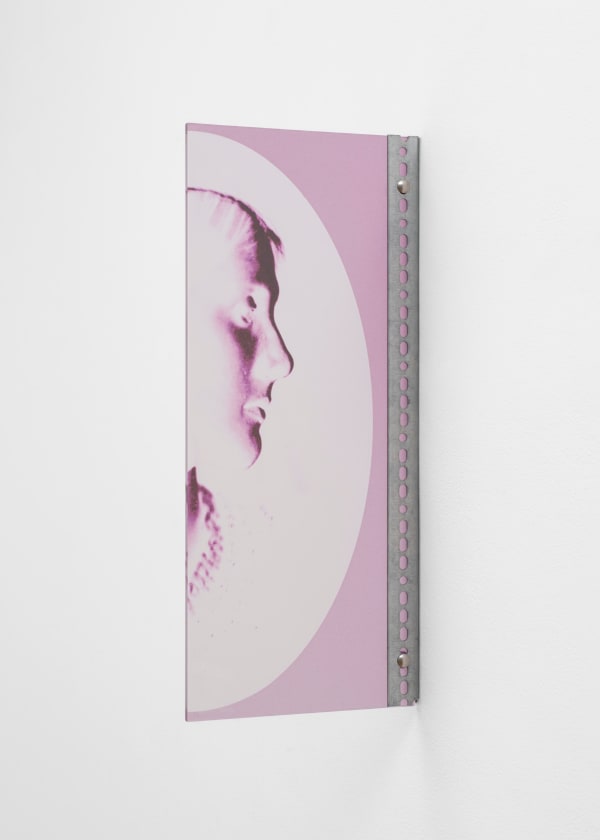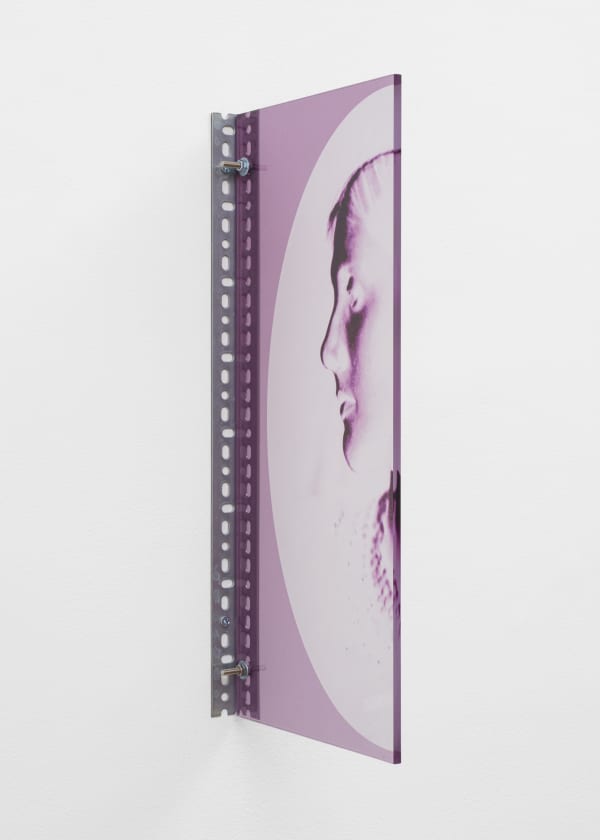OFFSCREEN 2024: Booth E.10
-
Lace Interlace: Sara VanDerBeek in Conversation with A Part of thePicture, 1989/1994 and WAR IS TERROR, 2001/2003 by Louise LawlerCo-presented by Altman Siegel and The Approach
-
-
 Sara VanDerBeek, Lace Interlace I-IV (detail), 2024
Sara VanDerBeek, Lace Interlace I-IV (detail), 2024 -
-
In VanDerBeek's Lace Interlace works, images of textiles, handmade and industrially produced, fragments of costumes, contemporary and historical, are layered and presented in custom designed frames made of lace-like perforated steel. The arrangement and layering of images, printed via advanced UV and Dye Sublimation processes, is inspired by the arrayed and accumulative organization of early photographic albums by Julia Margaret Cameron, Anna Atkins and Cowper that VanDerBeek has researched and captured over the course of her multi-year development of Lace Interlace. The tint and toning of 19th century albumen prints from which some of the included images were captured influenced VanDerBeek's overall palette of mauves, coppers, and grisaille. Lawler and VanDerBeek's shared interest in the life and afterlife of images and artworks and the public and private collections in which these works are housed furthers contemporary conversations around the complex functions and roles of photographic reproduction. The installation as designed by VanDerBeek presents a shifting temporality, simultaneously evoking mechanical artifacts of the Industrial Revolution, and contemporary museum storeroom's shelving systems to propose an artistic salon of the imagination.
-
-
-
-
-
-
"In late 2023, Louise Lawler and I engaged in a brief dialogue via email about her work WAR IS TERROR, 2001/2003. I was asking her permission to collage a reproduction of her work into my own composition entitled Women & Fiction, War is Terror, 2024. It's inclusion was an act of reverence for Lawler and her work, as well as its subject: a photograph by Julia Margaret Cameron of Julia Jackson Stephen, mother of Virginia Woolf and Vanessa Bell. Lawler had captured the portrait in Yvon Lambert's home outside Avignon, where it hangs over Fortuny fabric.
Lawler's striking composition of textile and image aligned with my own interests and research. I had recently photographed another Cameron portrait of Julia Jackson Stephen, amongst the extensive Julia Margaret Cameron holdings in the Photography Department of the Victoria & Albert Museum, London, as well as their collection of Isabel Agnes Cowper's early photographs of Lace. My capture of these historic photographic collections, and related textile collections at the Baltimore Museum of Art, and the Costume Institute, New York along with engagements with contemporary media artists such as Lawler, and Joan Jonas are foundational to the development of my series Lace Interlace, which explores the ongoing and evolving innovations of female practitioners in photography, textiles, and technologies of the past and present."
-
-
"The lace images included in Lace Interlace and Women & Fiction, War is Terror were captured from an album of photographs taken by Isabel Agnes Cowper. Cowper was the first female official museum photographer of the Victoria & Albert Museum. Working at the museum from 1868-1891, Cowper captured hundreds of objects and was particularly accomplished in capturing images of textiles and lace. Cowper's images of lace were also used in widely circulated educational publications and followed a tradition of pattern books created by and for women since the 1600s. Published at the start of the industrialization of textile production, Cowper's indexical and industrious views of lace present a complex narrative. Pedagogical yet delicately rendered their exacting detail is effective in empowering the work of the unattributed female creators of the lace pictured, yet their educational function in an empirical and encyclopedic institution, is a complex one that raises questions about museum practices and photography's role in codifying roles, and definitions of what is and isn't art.
Originally an act of collection and preservation, when I photographed Cowper's album page from an angle and through a digital camera's lens, it becomes something more "virtual" and of the imagination. Printed as a silver gelatin print the image of lace and the dark velvet plane on which it was originally captured in the 19th century becomes undulating and fugitive- and more a hybrid of past and present photographic technologies. The imaged page becomes a threshold upon which its history as it is resonant within my own pictorial lineage is explored."
-
-
"Upon learning about the origins of this image in my work, Lawler sent me her work, A Part Of The Picture, 1989/1994, also included in this presentation. The photograph depicts a moisture indicator atop lace taken at the Isabel Stuart Gardener museum in 1989. The functional museum device at its center reveals an intelligent self-reflexivity on behalf of Lawler. The apparatus of the museum, and the care and technicalities involved in the keeping of collections is elevated to subject. This unseen labor of care often carried out by women in the predominantly female-led fields of conservation and curation, is valued and formalized in Lawler's insightful work.
Through shared interests in and explorations of the public and private collections that house the works, of Cameron, Cowper, and other significant woman of the past, our photographic works collectively evoke an expanded appreciation of women's roles in the evolution of museological practices and photographic reproduction. The life and after life of images, is central to this presentation at OFFSCREEN and my practice overall."
- Sara VanDerBeek, 2024 -
-
Photography's foundations and its early practitioners continue to inform contemporary society's ideas of expression, communication and community. The installation at OFFSCREEN presents a poetic arrangement of images and ideas that encourage careful observation of details within the compositions and between the artworks on view. A conversation is presented between practices of the past, and contemporary photographic works encouraging a more collective understanding of art historical pasts and futures.
The background image of Soeurs, 2024, was captured by VanDerBeek at the Joseph and Anni Albers Archive in 2018. It is of an Anni Albers drawing for a print made in 1968. As a preeminent artist working in textiles, Albers work and writings in and on weaving, continue to be impactful to many artists including Lousie Lawler, who sent VanDerBeek an article about Albers when discussing the Lace Interlace project.
Albers's use of the grid as a dynamic field, was an important aspect of VanDerBeek's interest in capturing this composition and pairing it with the 18th c. lace from the Cone collection. In each, the hand of the creator is seen via the intricate detail and the mirroring of form, that is further expanded with its mirrored surface. Overall the combination of image, reflection, and relief strives for a visual experience that is continually shifting and resonant of multiple times and cultures- from the Pre-Columbian influences on Albers's drawing, the fine hand work of anonymous women who made the lace in pre-modern Europe, to the Cone Sisters who collected and preserved the lace for posterity in Baltimore. The advanced UV relief print of the historic lace also addresses the potential future life of textiles and collections. In an act of recreation, the lace is formed through image and digital printing to establish a new form.
-
-
-
Isabel Agnes Cowper was the first female Official Museum Photographer at the Victoria & Albert Museum, where she lived with her four surviving children. For VanDerBeek, it is Cowper's expertise in documenting lace that is most fascinating, with lace acting as a direct and metaphorical proxy for female production. Lace in the 19th century was primarily created by women for women. Its production by hand was heavily politicized at the time of its capture by Cowper. During the rise of industrialization, Jacquard and other mechanical looms were met with protest, and the negative and sometimes fatal impact upon the, often female, loom operators was widely reported.VanDerBeek sees this simultaneous confluence and conflict of the body and the machine as it evolved in textile manufacture as not only paralleled in the development of photographic reproduction, but, as the new works in Lace Interlace explore, to be foundational to contemporary society's complex relationship with photographic images. These nascent technologies are increasingly cited as the origins of early computational programming and design, and become symbolic in VanDerBeek's use of the ongoing impacts of mediation upon individual and collective memory.While Cowper's style might be defined by a highly meticulous and methodical approach, in order to accurately index and organize museological objects, Julia Margaret Cameron worked from the other end of the medium, both in style and subject matter. Cameron's practice can be distinguished by her use of soft-focus, creating romantic photographic portraits of friends and family - mostly women - including her niece Julia Jackson Stephen, mother of Virginia Woolf and Vanessa Bell.Prompted by the differences between Cameron and Cowper's work, Lace Interlace synthesizes the historical and the personal, the institutional and the private. The work combines photographic fragments of past and present practitioners - including rephotographed images taken by VanDerBeek of Cowper and Cameron's work - alongside more enigmatic images taken from life and from the television and computer screens used in VanDerBeek's home and studio.These images are toned in colors inspired by the Albumen prints created by Cowper and Cameron. The artist's design for these work's custom frames references the photographic mattes employed in the Victorian era, industrial lace looms, and the unit-based engineering of museum and studio storage systems. Addressing the evolution of the medium, VanDerBeek has utilized different photographic techniques, layering digital iPhone and SLR capture with the shifting focus of medium format film, as well as incorporating contemporary print processes such as Dye Sublimation and UV printing.Lace Interlace emerges from VanDerBeek's long-form and ongoing project Women & Museums which explores both the recognized and unrecognized contributions of women towards contemporary understandings of material cultures, mediation and female experience across time and place as it is collected, housed and displayed within an international network of museums and art institutions.
-
-
-
-
-
-
Sara VanDerBeek (b. 1976, Baltimore, MD) lives and works in Brooklyn, NY. VanDerBeek's interdisciplinary practice centers upon photographic reproduction, its history and its evolving contemporary forms. Recent work has focused on museological practices of collection and display. Within this context, VanDerBeek highlights women's ongoing contributions to the larger material and visual cultures upon which institutional collections and art historical narratives are built.
Solo exhibitions include Lace Interlace, The Approach, London, UK, (2023), Chorus, Altman Siegel, San Francisco, CA (2021); Women& Museums, Metro Pictures, New York, NY; VanDerBeek+VanDerBeek, Black Mountain College Museum, Asheville, NC; Women & Museums, Minneapolis Institute of Art, MN (all 2019); Baltimore Museum of Art, Baltimore, MD; Museum Boijmans van Beuningen, Rotterdam; The Approach, London, UK (all 2015); Museum of Contemporary Art Cleveland, OH (2014); Foundazione Memmo, Rome, Italy (2012); The Hammer Museum, Los Angeles, CA (2011); and Whitney Museum of Art, New York NY (2010). Recent group exhibitions include Tabula Rasa, Paula Cooper Gallery, New York, and Mother Lode: Material and Memory, James Cohan Gallery, New York (2024).
VanDerBeek's work is in art collections worldwide including the Guggenheim Museum, Hammer Museum, LACMA, Los Angeles, ICA, Boston, ICA Miami, MoCA, Los Angeles, MoMA, New York, The Whitney Museum of American Art, New York and Walker Art Center, Minneapolis, Minnesota amongst others. VanDerBeek is a recipient of a Smithsonian Artist Research Fellowship (2022) and a Pollock- Krasner Foundation grant (2023). The first monograph of her work was published by Hatje Cantz, in 2016.




